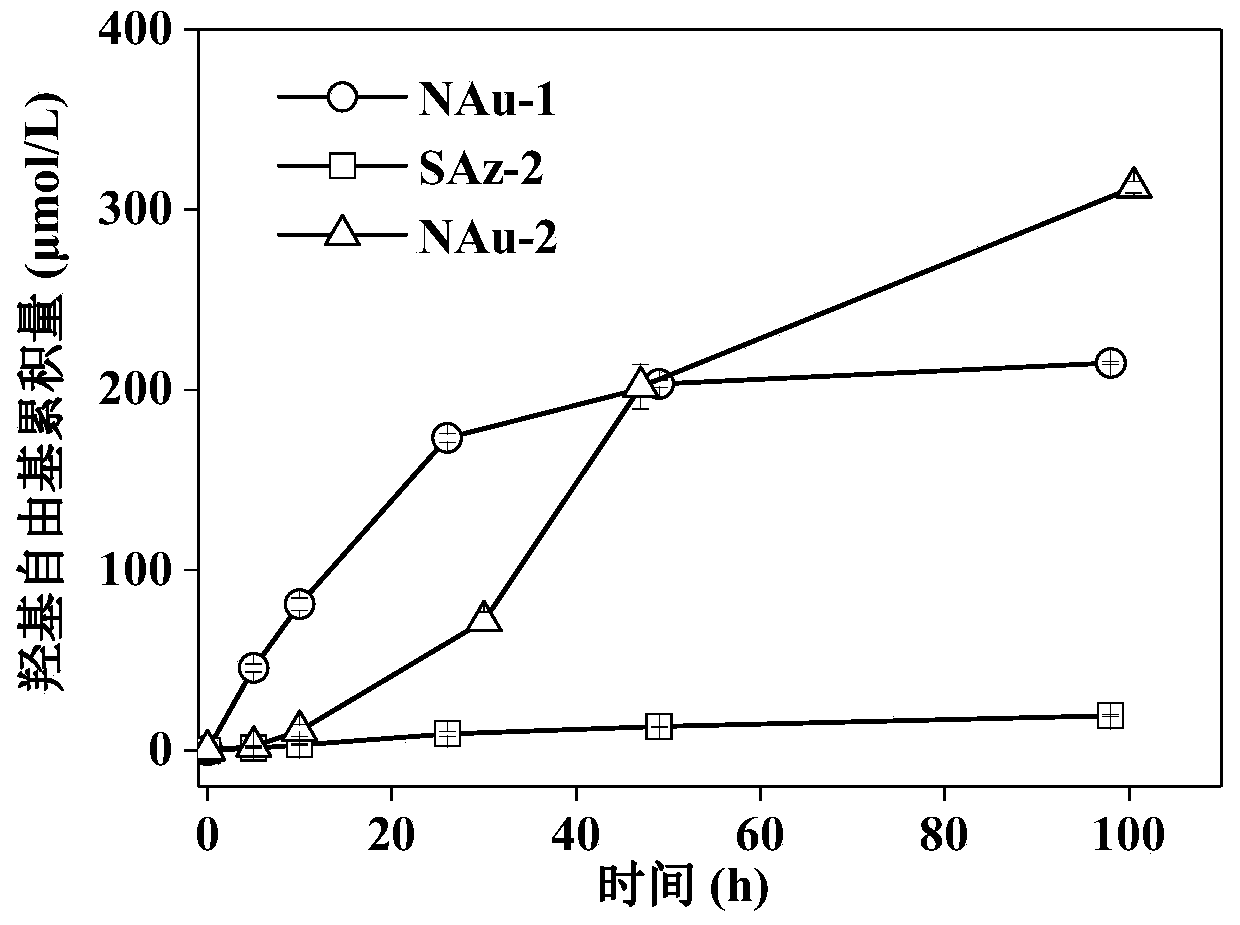Composition for reducing arsenic toxicity and application thereof
A composition and technology of arsenic toxicity, applied in the field of soil and water pollution treatment, can solve the problems of oxidant secondary pollution, metal dissolution toxicity, etc., and achieve the effect of reducing toxicity
- Summary
- Abstract
- Description
- Claims
- Application Information
AI Technical Summary
Problems solved by technology
Method used
Image
Examples
Embodiment 1
[0027] Step 1, two kinds of nontronite clays (NAu-1 and NAu-2) and one kind of montmorillonite clay (SAz-2) were pulverized to collect 0.5-2µm particles for later use;
[0028] Step 2, add 0.1g of the clay particles in the above step 1, 1mL 100mmol / L cysteine, 1mL 200mmol / L benzoic acid solution with pH=5.7 into the glass bottle, add deionized water to dilute to 20mL, The sample was stirred and reacted with a magnetic stirrer in the air;
[0029] Step 3: After 0, 4, 10, 24, 48, and 96 hours, take out 0.9 mL of the sample and add it to 0.1 mL of methanol, filter the solution with a 0.22 µm water filter, and store the filtrate in a 4°C refrigerator for later use;
[0030] Step 4, detecting the content of p-hydroxybenzoic acid in the filtrate of step 3 is used to indicate the concentration of hydroxyl radicals.
[0031] Such as figure 1 The experimental results show that compared with montmorillonite, nontronite can generate a large number of hydroxyl radicals in a short time, ...
Embodiment 2
[0033] Step 1, the nontronite clay is pulverized to collect particles of 0.5-2 µm, and set aside;
[0034] Step 2, add 0.1g or 0.08g or 0.06g or 0.04g or 0.02g or 0g of the clay particles in the above step 1, and 2mL 100mmol / L cysteine, 1 mL 200mmol / L pH = For the benzoic acid solution in 5.7, add deionized water to make the volume to 20mL, and stir the sample in the air with a magnetic stirrer;
[0035] Step 3, after 96 hours, take out 0.9mL sample and add it to 0.1mL methanol, filter the solution with a 0.22 µm water filter membrane, and store the filtrate in a refrigerator at 4°C for later use;
[0036] Step 4, detecting the content of p-hydroxybenzoic acid in the filtrate of step 3 is used to indicate the concentration of hydroxyl radicals.
[0037] Such as figure 2 The experimental results show that when the concentration of nontronite is greater than 3g / L, the accumulation of hydroxyl radicals reaches the peak value. Therefore, in order to achieve the best effect when...
Embodiment 3
[0039] Step 1, the nontronite clay is pulverized to collect particles of 0.5-2 µm, and set aside;
[0040] Step 2, add 0.1g of clay particles from step 1 above, 1mL 100mmol / L or 80mmol / L or 60mmol / L or 40mmol / L or 20mmol / L or 0mmol / L cysteine, and 1 mL 200mmol / L of benzoic acid solution with pH=5.7, add deionized water to make the volume to 20mL, and stir the sample in the air with a magnetic stirrer;
[0041] Step 3, after 96 hours, take out 0.9mL sample and add it to 0.1mL methanol, filter the solution with a 0.22 µm water filter membrane, and store the filtrate in a refrigerator at 4°C for later use;
[0042] Step 4, detecting the content of p-hydroxybenzoic acid in the filtrate of step 3 is used to indicate the concentration of hydroxyl radicals.
[0043] Such as image 3 The experimental results show that the higher the concentration of cysteine, the more accumulation of hydroxyl radicals, so the optimal concentration of cysteine is 5mmol / L.
PUM
 Login to View More
Login to View More Abstract
Description
Claims
Application Information
 Login to View More
Login to View More - R&D
- Intellectual Property
- Life Sciences
- Materials
- Tech Scout
- Unparalleled Data Quality
- Higher Quality Content
- 60% Fewer Hallucinations
Browse by: Latest US Patents, China's latest patents, Technical Efficacy Thesaurus, Application Domain, Technology Topic, Popular Technical Reports.
© 2025 PatSnap. All rights reserved.Legal|Privacy policy|Modern Slavery Act Transparency Statement|Sitemap|About US| Contact US: help@patsnap.com



